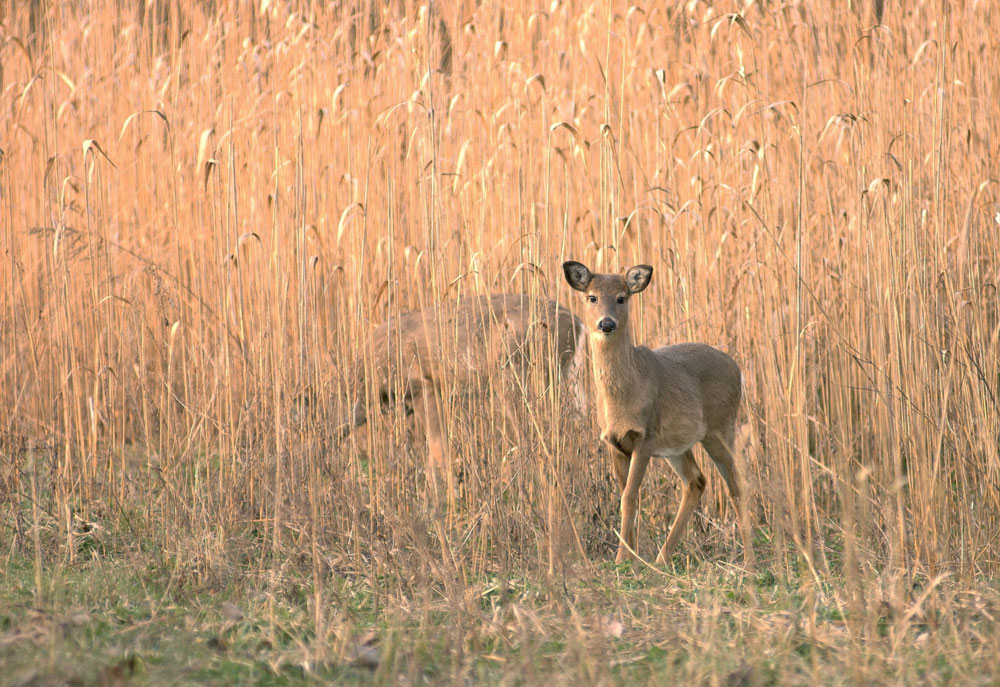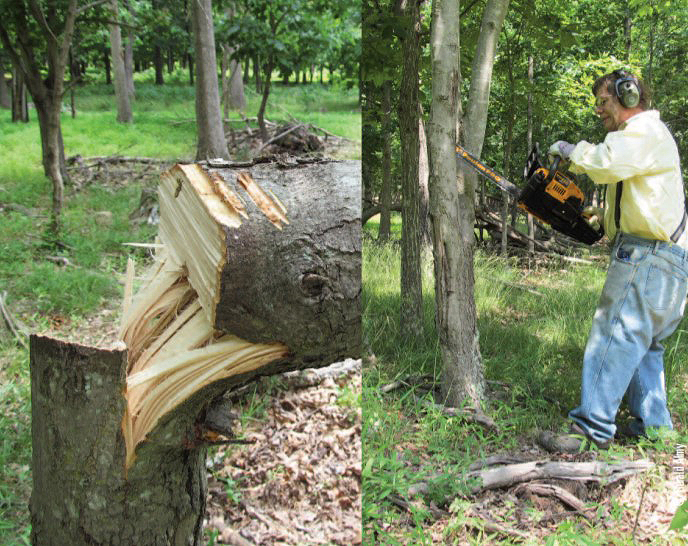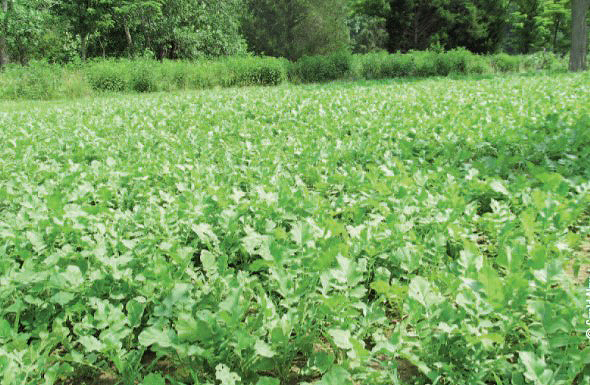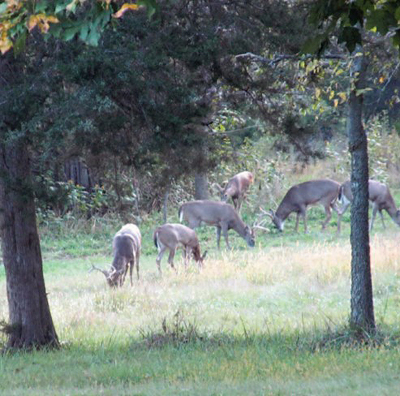Gerald Almy | Originally published in GameKeepers: Farming for Wildlife Magazine. To subscribe, click here.

Planting and maintaining food plots is one of the best projects a gamekeeper can undertake to attract whitetails to a property. It’s also probably the most fun habitat improvement activity. Watching crops grow from tiny seeds into lush green plots that are being utilized by your herd and knowing how much value the protein and nutrients have provided bucks growing antlers and does raising their fawns brings a deep feeling of satisfaction.
But without enough of a second ingredient, you simply won’t be able to keep deer on that property. That ingredient is cover. Some places have all the cover needed naturally, but for most properties cover is often the crucial ingredient lacking to hold whitetails on a given tract of land. The “edge” or “ecotone” between two cover types is really most important, but anywhere you can create thick, protective shelter the more living space you’ll have for your whitetails. Not only will you attract more whitetails, but you will hold them on your property.
They may visit regularly to feed on your plots, acorns or fruit trees, but if you don’t have cover, and lots of it, mature bucks in particular won’t stay. If they don’t stay there, not only will you have less chance to harvest them, you may lose control of the decision on when they are old enough to take. If a buck leaves your land for a thick, overgrown parcel next door, the neighbor there may think that a two-year old eight-pointer is just the deer he wants to fill his freezer.
If you’re blessed with all the natural cover you need in exactly the right areas, congratulations. For most gamekeepers, adding cover or managing the cover you have correctly is the best way to make a property attractive to deer 24/7, not just to visit to feed, but to live there. If you’re creating this cover, it’s also important to carefully consider where you locate it and how you lay it out to get the most hunting benefits from it. If you do things correctly, you can dictate to your herd where they will bed, where they will travel and where they will feed and that makes hunting them so much easier.
Here’s a “tool box” of seven types of cover you can create that will help turn a property into a paradise for deer when combined with native natural foods, fruit trees, oaks, food plots and a few water sources. In other cases, you can use this list to identify and categorize the cover types that you already have on your property. This is equally important so that you can preserve and enhance them, managing each cover type in the best way possible to benefit that cover and thus the wildlife.

1. Warm Season Grasses
Native grasses such as switchgrass, Indian, big and little bluestem, and gamma grass once covered much of North America. Sadly, they’ve been lost throughout most of the country as fields were converted to commercial crops or cool season grasses such as fescue.
Fortunately, with a little effort warm season grasses are fairly easy to establish. Planting can be done by broadcasting or best of all, with a special drill made for these seeds that you can often rent from farm co-ops and conservation groups. Growing 5-7 feet tall, these native grasses provide superb security cover when hunting pressure mounts. Besides the species mentioned above, consider Nativ Nurseries Bedding Blend and Barrier Blend seeds mixtures which contain several of the beneficial warm season grasses mentioned.
If yours is the only property in the area that has them, you’ll likely get a strong influx of bucks into stands of these grasses when hunting pressure builds. They also provide prime fawn rearing locations and escape from harsh winter weather. Animals will find both warmer temperatures and protection from pummeling winds in thick stands of these grasses that block the breezes, but allow the sun to penetrate and warm them.
Plant NWSG’s in blocks, strips, or large fields during spring or early fall. Expect to wait a year or two before you get a good stand. Patience is required. When you do get a nice field, hunt it very little, or not at all, leaving it as security and escape cover. Burn every three years to manage the stand or simply leave it alone.

2. Conifer Stands
Depending on where you live, the species will vary, but evergreen trees can be of great cover value for deer. Or maybe not, if you have larger, mature trees scattered widely throughout the property, roosting spots for turkeys is about all they’ll be good for.
On the other hand, dense younger stands of pines, spruce, fir, hemlock, cedar and other species can offer prime cover for whitetails. They’ll use it in summer for the cooling effect the dense canopy offers. And they’ll use the evergreens during winter as thermal cover and for shelter – in northern regions sometimes yarding-up in them in sizeable herds to await the return of spring. They may offer some food value as well in those cases.

hideouts and wonderful edge habitat. Here we see where
conifers (cedars and Virginia pines) and a stand of NWSG
about one another.)
The best cover value from evergreens comes in the form of young, dense stands of cedar or pine that grow so thick it’s hard for a man to walk through. Cedars may choke out most other plants because of their dense canopy, but as they mature they hold their cover low to the ground. Pines will often allow weeds, saplings, and vines to thrive between them in their immature growth stages. This creates superb bedding, escape, and thermal cover. And many of these intertwining weeds and vines are edible plants, providing valuable secondary foods.
Bucks will often hunker down in this thick mass of pine branches and brush, venturing out into food plots and fields right at dusk, or when they see an estrous doe. That’s what happened for Tony Fulton, of Mississippi, on a winter hunt during the rut.
He had planted pines next to a food plot that became choked with weeds and vines as the stand grew. That superb cover is exactly where a buck stepped out on a cold afternoon in January, allowing Fulton to kill what was then the largest buck ever taken by a firearms hunter at 295 6/8 net B&C.
Get advice from your local forestry or game department on species, but by all means, plant some conifers in small pockets, strips along borders, near food plots, and in larger winter bedding areas for thermal cover. Bought as seedlings from sources such as your state forestry department or nativnurseries.com, these trees are fairly inexpensive. And they’ll improve almost any property, especially those that consist mostly of deciduous trees and open fields.
3. Annual Cover Crops
Annual cover crops, such as Egyptian wheat, sorghum, Sudan grass, and combinations of various tall-growing annuals such as Biologic’s Blind Spot can offer a quick way to create cover for strategic goals. Say you have a food plot site but it’s only accessible across an open field from buck bedding cover. Sow a strip of these plants in spring or early summer to create security cover that will draw mature deer out earlier, in shooting light.
Another use is for creating a screen for an access route so you can approach your stand or blind without being detected. Yet a third instance where these tall-growing annuals can be of value is to shield the view from cars on roads or a neighbor’s property so they aren’t tempted if they see a good buck on your land.
4. Shrubs
Shrubs are often a forgotten element in creating cover for deer. Chances are you already have quite a few shrubs on your land. Some are likely valuable as food and cover. Others just cover. But as long as they’re not invasive species or harmful, I like all the shrubs I can have. Deer love to bed down in these low-growing plants either all day or temporarily as they approach major feeding fields. And the edible ones also offer extra food value.
Try to identify those you have and daylight some of the beneficial ones if they’re becoming too shaded or expand them with a bit of tree clearing. (Most shrubs thrive in partial sunlight and don’t grow well in dense mature forests). You can also fertilize some of them with good effect because of their shallow root structure.
It’s also worthwhile to plant shrubs, but I like to do so strategically. For instance, a creek bottom might serve as a prime travel corridor for bucks between a bedding area and feed field, but is too open. Planting a few rows of shrubs along it, perhaps mixed with some pines, can give just enough cover that they’ll use it during daylight. And having created it, you’ll know exactly where to hang your stand.
In another situation a potential staging area may be a bit too open. Adding a few shrubs will help make this gathering area more attractive to mature bucks earlier in the afternoon.
A wide variety of shrubs beneficial to wildlife are available from Nativ Nurseries or state forestry departments. Some good species include Allegheny chinquapin, plum, native honeysuckles, raspberry, blackberry, American beautyberry, strawberry bush, and gray or red osier dogwood.

you only have food and no cover, your results will likely be
below expectations. Even if you do attract deer, you won’t
hold them without the cover. Here we see a group of bucks
feeding in clover near thick cover.
5. Hinge cuts or Dzer-Felled Trees
This type of cover has received lots of coverage recently, so we’ll just touch lightly on it here. Suffice it to say; done correctly, this tactic can create some great whitetail cover.
Just know what species you’re hinge cutting and follow all safety rules. And don’t try to hinge-cut large trees. Stick to smaller to medium trees up to about 8-inches in diameter. Cut just through far enough so the tree falls or you can push it over, at waist to chest height. The tree will continue growing for a while (hopefully) and provide both cover and valuable browse for deer.
You can create bedding areas this way or pockets of security cover. This is also a strategy to even block routes you don’t want deer to take so they will travel past your stand. Cut a lot of the trees at a right angle to the path you want them to take and a few parallel to it. And leave a few escape slots. Deer don’t want to feel totally “trapped” by your funnel.
If you have a dozer or want to rent or hire an operator for a day, you can also knock down small trees so they’re almost growing parallel to the ground. This alternative often results in the tree continuing to grow close to the ground where it offers more cover and potential food from the twigs and leaves that are now at “deer mouth” level. Have a plan, though, as to exactly which tree species to cut and where to create the movement-channeling effect you want.
6. Clear Cuts
You’ll likely want to hire a logger to create this type of cover. Not only will it result in thick, wonderful bedding and escape cover when the area grows back over the next two to five years, you’ll likely get some income back that you can plow into other habitat projects.
7. Agricultural Crop Cover
Most crops are planted for human or livestock food, to produce income and to provide nutrition for wildlife. But some of them, while standing, also offer great cover.
Corn is the obvious example. But lablab and some thick growing forage soybeans can also offer enough cover that deer will not only feed in the fields or plots but also bed in them during summer and early fall. These legumes can be enhanced for cover by mixing in some taller growing plants that will provide anchors for the beans and lablab to cling to and climb as they grow; producing still more forage and cover. These include sunflowers, sorghum, and sunn hemp.
You can get a veritable jungle of food AND cover with these mixtures in good soil with a balanced pH, high nutrient level, and adequate rainfall. Just be sure to plan out your hunting strategy when you lay these fields out. Consider wind direction and potential stand locations for bow hunting in early season near the bean and nurse crop fields or how you’ll want to approach a rifle hunt near strips of unharvested standing corn during the late season.































